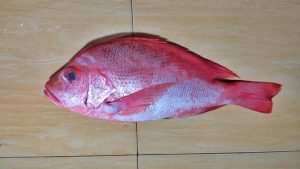Der Northern Red Snapper, mit seinem zoologischen Namen Lutjanus campechanus, ist ein Salzwasserfisch aus der Familie der Schnapper (Lutjanidae), der vor allem im westlichen Atlantik beheimatet ist. Es handelt sich dabei um eine Fischart, die nicht nur bei Sportanglern sehr beliebt ist, sondern auch kommerziell gefischt wird und eine wichtige Rolle in der Küstenfischerei spielt. Mit seinem auffallenden, namensgebenden roten Schuppenkleid ist er nicht nur optisch markant, sondern auch Ziel zahlreicher ökologischer Studien.
Der Northern Red Snapper kann beachtliche Größen erreichen und in seltenen Fällen ein Alter von über 50 Jahren haben. Überwiegend lebt der Schnapper in Tiefen bis zu 190 Metern, bevorzugt jedoch meist die Bereiche um Riffe und Sandbänke, wo er sich von Krebstieren, kleineren Fischen und anderen Meereslebewesen ernährt. Als wichtiger Raubfisch trägt er erheblich zum ökologischen Gleichgewicht seiner maritimen Umgebung bei.
Angesichts seiner Popularität sowohl in der Freizeitfischerei als auch in der Wirtschaft ist der Bestand des Northern Red Snappers zunehmendem Druck ausgesetzt. In manchen Regionen wird von Überfischung berichtet, was eine geregelte Bewirtschaftung und Schutzmaßnahmen notwendig macht. Diese sind entscheidend, um den Fortbestand der Art zu sichern und die Nachhaltigkeit der Fischerei zu gewährleisten.
Abgesehen von seiner ökonomischen Bedeutung ist der Northern Red Snapper auch Teil der kulturellen Identität vieler Küstengemeinden, insbesondere im Golf von Mexiko und entlang der Südostküste der USA. Kulinarisch ist er vor allem für sein festes, weißes Fleisch bekannt, das vielseitig zubereitet werden kann und in der regionalen Küche hochgeschätzt wird.
Northern Red Snapper Fakten
- Klasse: Actinopterygii (Strahlenflosser)
- Ordnung: Perciformes (Barschartige)
- Familie: Lutjanidae (Schnapper)
- Gattung: Lutjanus
- Art: Lutjanus campechanus (Northern Red Snapper)
- Verbreitung: Westlicher Atlantik, Golf von Mexiko, Karibik
- Lebensraum: Riffgebiete, felsige Untergründe, meistens in Tiefen von 10 bis 190 Metern
- Körpergröße: Bis zu 1 Meter
- Gewicht: Kann über 20 kg wiegen
- Soziales Verhalten: Bildet oft Schulen, insbesondere in jüngeren Lebensphasen
- Fortpflanzung: Laichen findet zwischen Juli und September statt; Eier und Larven sind pelagisch (treiben frei im Wasser)
- Haltung: In Aquarien eher selten gehalten, da große Tankgrößen und spezielle Bedingungen nötig sind
Systematik Northern Red Snapper ab Familie
External Characteristics of Northern Red Snapper
The Northern Red Snapper exhibits a distinctive body shape that is typical of snappers, characterized by a laterally compressed form and a moderately deep body. The coloration is one of its most striking features; adults typically display a bright red or pinkish hue on their upper body that fades to a lighter shade on the belly. Juveniles often have a dark spot located below the soft dorsal fin, which can help differentiate them from other species.The dorsal fin consists of 10 spines and 14 soft rays, while the anal fin has three spines and eight to nine soft rays. The mouth is relatively large with sharp conical teeth adapted for grasping prey. The eyes are small and red, adding to their distinctive appearance. As they grow older, their coloration may change slightly, with deeper hues observed in fish residing in deeper waters.
Habitat and Distribution
Northern Red Snappers are predominantly found in the western Atlantic Ocean, with their range extending from Massachusetts down to the Gulf of Mexico and throughout the Caribbean Sea. They inhabit various depths but are most commonly found between 30 to 190 meters (100 to 620 feet), often residing near rocky substrates or coral reefs where they can find ample food sources.These fish undergo habitat changes as they mature; juveniles tend to settle in shallower waters with sandy or muddy bottoms before moving to more complex habitats like reefs as they grow larger. Adult Northern Red Snappers prefer environments with high relief structures such as ledges and wrecks, which provide both shelter and hunting grounds.
Behavior of Northern Red Snapper
Northern Red Snappers are known for their gregarious nature; they often form large schools around underwater structures such as reefs or shipwrecks. This social behavior not only aids in protection from predators but also enhances their foraging efficiency as they hunt for prey collectively.As predators, these snappers primarily feed on smaller fish, crustaceans, squid, and other benthic organisms. Their feeding habits change as they grow; juveniles typically consume zooplankton while adults target larger prey items. This shift in diet reflects their increasing size and predatory capabilities.
Mating and Reproduction
Reproductive activities for Northern Red Snapper typically occur from late spring through summer when water temperatures rise. They engage in a spawning behavior known as broadcast spawning, where multiple females release eggs simultaneously with males releasing sperm into the water column. This method increases fertilization success by dispersing eggs away from potential predators.Females can produce millions of eggs during each spawning event, contributing significantly to population replenishment. After fertilization, the eggs float on the surface until they hatch approximately 20-27 hours later into larvae that are initially planktonic. As they mature into juveniles, they seek out protective habitats such as shell beds before transitioning to reef environments.
Conservation Status
The Northern Red Snapper faces several threats that have led to concerns regarding its population sustainability. Overfishing has been a significant issue due to high demand in commercial fisheries. Additionally, juvenile snappers often fall victim to bycatch during shrimp trawling operations aimed at other species.Conservation efforts have been implemented in various regions to regulate fishing practices and protect habitats crucial for the survival of this species. These measures include seasonal closures and size limits designed to allow populations time to recover. With effective management strategies in place, there is potential for Northern Red Snapper populations to rebound despite current pressures.
Sources
https://biogeodb.stri.si.edu/caribbean/en/thefishes/species/3686
https://en.wikipedia.org/wiki/Northern_red_snapper
https://www.floridamuseum.ufl.edu/discover-fish/species-profiles/lutjanus-campechanus

